<< Previous | Displaying results 4141-4150 of 6776 for "" | Next >>
One of many signs displayed along the Shanghai ghetto's boundaries: "Stateless Refugees are Prohibited to Pass Here without Permission". This plaque was removed by a refugee at the end of the war. [From the USHMM special exhibition Flight and Rescue.]
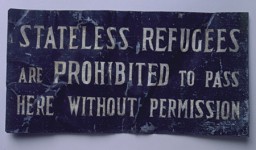
Pants worn by Marjan Glass as he dug anti-tank ditches for the defense of Warsaw, Poland, and then as he hastily fled the city ahead of the German advance on September 7, 1939. Glass, a lawyer, escaped with his wife and three-year-old son, and his wife's mother and brother. He left without taking the time to change from his soiled work clothing. [From the USHMM special exhibition Flight and Rescue.]

A seven-day gold traveling clock in a leather case, manufactured in France and originally made for a Russian nobleman. The panel in the leather case slides open to reveal the clock face. The clock was a Szepsenwol family heirloom. It was acquired by Chaya Szepsenwol's grandfather, who like her father, was a jeweler. The clock was among the family valuables that Rikla Szepsenwol was able to take out of Poland. [From the USHMM special exhibition Flight and Rescue.]
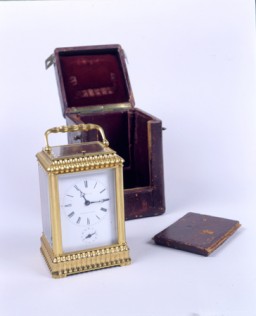
This poster from Munich, Germany, proclaims the April 1, 1933, boycott of Jewish-owned businesses and services offered by Jewish professionals. It calls on all Germans to honor the boycott, which began at 10 a.m. The poster was signed by the radical Nazi antisemite, Julius Streicher, official organizer of the boycott.
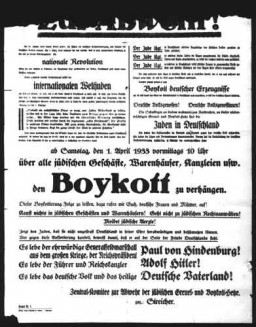
The program cover for "We Will Never Die" featured Arthur Szyk’s "Tears of Rage" artwork. The cover's original dimensions are: 12 1/16" x 9 1/16" x 3/16.
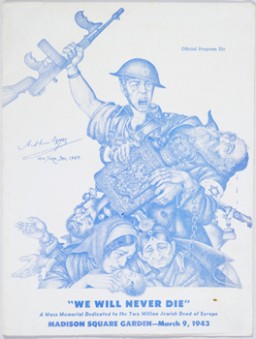
View of the countryside in Csobanka, Hungary, as the Hungarian Labor Service company 109/13 departs on the morning of April 20, 1942. [Photograph #57952]
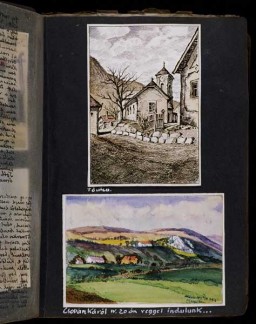
(Bottom) In a drawing dated April 18, 1942, Beifeld shows the school where the Hungarian Labor Service company 109/13 was quartered in Csobanka (Szentendre district), Hungary, before its departure for the Ukraine. A group of Hungarian soldiers [assigned to the labor service company] sits outside in the schoolyard. [Photograph #57947]

In a drawing dated April 14, 1942, Beifeld shows houses in Csobanka (Szentendre district), Hungary, where the Hungarian military officers assigned to the labor service company were quartered before their departure for the Ukraine. [Photograph #57949]

(Middle) In a take-off of travel posters advertising peaceful vacation spots, Beifeld draws a picture of a Hungarian military tent pitched next to a tree on which a bird is cheerfully chirping. Next to the tent the artist writes "Peaceful Surroundings" but above, a Soviet bomber releases a bomb aimed at the tent. [Photograph #58022]
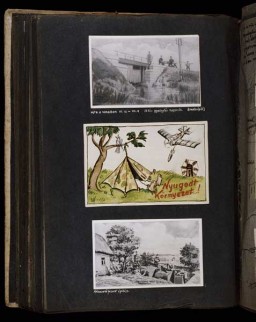
(Bottom) View of fortifications built at Kalimovka to defend the advancing troops of the 4th Infantry Division of the Hungarian 2nd Army. In the lower right corner of the drawing, men prepare the grave of Jewish Labor Serviceman Nandor Klein, the first fatality of the company. The Hungarian caption reads: The death of our first hero, Nandor Klein, his grave, June 5, 1942." Klein was killed by a stray Soviet bullet on his way back to base. [Photograph #58013]
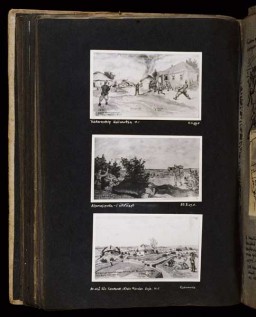
We would like to thank Crown Family Philanthropies, Abe and Ida Cooper Foundation, the Claims Conference, EVZ, and BMF for supporting the ongoing work to create content and resources for the Holocaust Encyclopedia. View the list of donor acknowledgement.